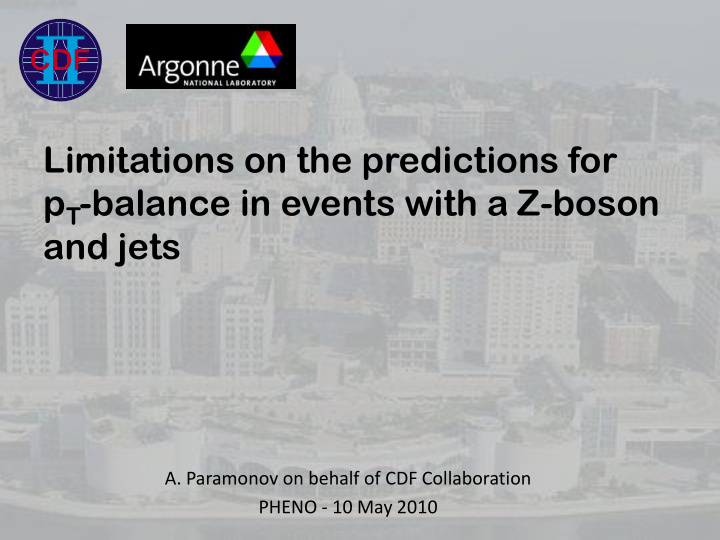



Limitations on the predictions for p T -balance in events with a Z-boson and jets A. Paramonov on behalf of CDF Collaboration PHENO - 10 May 2010
Introduction • We focus on aspects of the Monte Carlo (MC) simulations which affect jet energy – Jet p T – Top mass – Missing-E T – Background Estimates – Di-jet invariant mass • Accurate description of multi-jet final states is important for the discovery potential of the LHC experiments. • Identify and measure theoretical uncertainties contributing to the jet energy measurements – Renormalization and factorization scales – Choice of PDFs – Initial and final state radiation (FSR and ISR) – Leading – log parton shower (PS) • Indicate which elements of the MC simulations (PYTHIA) have to be improved to get more accurate predictions 2
The CDF II Detector 4.62 fb -1 of pp-bar collisions from the Tevatron accelerator • Electromagnetic Muon calorimeter Chambers Beam Inner Tracker Hadronic Beam Calorimeter 3
Definition of a jet and JES Thanks, Florencia. • 4-momenta of the calorimeter towers are grouped into “calorimeter jets” using jet clustering algorithm (JETCLU, cone = 0.4, 0.7,1.0). • Energy (momentum) of a calorimeter jet is normalized to that of a particle or parton jet (called JES) • Corrections account for – Instrumental effects – Physics effects – Jet clustering algorithm • Uncertainties are included in JES 4
Analysis technique • P T -balance in events with a Z-boson and a Jet – Uncertainties and features of theory predictions for the P T (jet)/P T (Z) as a function of P T (Z) • Jet Energy Scale at CDF State-of-art measurement with 300 pb -1 • Now we revisit individual uncertainties caused by SM simulations, PYTHIA, using a high-statistics dataset • Out-of-Cone (dashed red) dominates at low P T 10.1016/j.nima.2006.05.269 arXiv:hep-ex/0510047v1 5
Event Selection Z-boson is back-to-back to a jet: • Z→e + e - • Z→μ + μ - • 80 < M(Z) < 100 GeV • JETCLU clustering (cone sizes: 0.4, 0.7, & 1.) • PT( jet1 ) > 8 GeV • 0.2 < | η (jet1)| < 0.8 • P T (jet2) < 8 GeV • | Δφ (Z – jet1)| > 3.0 rad. • P T (Z) > 25 GeV (to avoid soft, poorly measured jets) P T (jet)/P T (Z): good agreement when P T (jet2) < 3 GeV: Perfect 2-body system 6
SM Predictions (MC generators) PYTHIA (stand-alone) ALPGEN+PYTHIA (Matrix Elements & Parton (used to establish JES) Shower calculations) Exact ME for Z+0p + a correction to Initial Exact ME’s for up to 4 partons State Radiation No need for jet-parton matching Jet-parton matching is @ 15 GeV for cone- 0.4 jets to avoid double-counting Same UE, Same PDF (CTEQ5L), same showering Stand-alone parton showering does not describe hard radiation at large angles well. Correctly described with ME for Z+2p calculation (e.g. 10.1103/PhysRevD.79.011101 Alpgen) 7
Observed P T -balance • Jets in Pythia samples have 4.7% more energy than in data for P T (Z) > 25 GeV • Measured energy is sensitive to the fraction of quark and gluon jets. • Is the mix of quark and gluon jet properly modeled? • Do PDF’s and tree -level diagrams give the right fraction? CDF Run II Preliminary CDF Run II Preliminary 8
Validation: rapidity distributions • The rapidity distributions are sensitive to PDF’s and contributions from qg→Zq and qqbar→Zg diagrams • Pythia and Alpgen describe data well • ME and PDFs are correct in Pythia CDF Run II Preliminary CDF Run II Preliminary 9
Validation: # of tracks • Number of tracks observed within the jet cone • Pythia describes in-cone hadronization and fragmentation accurately • Many other studies of shower properties • In-cone radiation is well modeled; quark-gluon fraction is correct CDF Run II Preliminary CDF Run II Preliminary 10
Summary of Uncertainties • We have went the uncertainties on the SM MC simulations • The uncertainty due to large-angle parton radiation (FSR) is the largest on the theoretical predictions CDF Run II Preliminary The table presents variation of the MC prediction of <P T (jet)/P T (Z)> in % (percent) and the difference between data and PYTHIA predictions (The observed discrepancy). 11
Uncertainty on the out-of-cone radiation • Study out-of cone radiation with correlations between P T -balance and properties of the 2 nd jet. • Data indicates that PYTHIA underestimated the amount of out-of-cone radiation (large-angle FSR) • Discrepancy becomes smaller with larger jet cone sizes. • Overall, impressive agreement between the LO simulation and data CDF Run II Preliminary CDF Run II Preliminary 12
Conclusions • We have investigated the systematic uncertainties affecting the measurements of jet energies • Overall, PYTHIA describes data very well • Parton radiation at large angles is the largest source of uncertainty on the predictions • A new generation of SM simulations (and new tunes) promise more accurate predictions: – MC@NLO – Powheg – New parton showers and their tunes in Pythia and Herwig 13
Backup 14
Single Particle response • G-Flash shower parameterization was tuned with single beam and minimum bias data 15
Recommend
More recommend